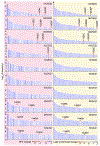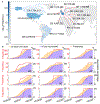Mechanisms of SARS-CoV-2 Evolution Revealing Vaccine-Resistant Mutations in Europe and America
- PMID: 34873910
- PMCID: PMC8672435
- DOI: 10.1021/acs.jpclett.1c03380
Mechanisms of SARS-CoV-2 Evolution Revealing Vaccine-Resistant Mutations in Europe and America
Abstract
The importance of understanding SARS-CoV-2 evolution cannot be overlooked. Recent studies confirm that natural selection is the dominating mechanism of SARS-CoV-2 evolution, which favors mutations that strengthen viral infectivity. Here, we demonstrate that vaccine-breakthrough or antibody-resistant mutations provide a new mechanism of viral evolution. Specifically, vaccine-resistant mutation Y449S in the spike (S) protein receptor-binding domain, which occurred in co-mutations Y449S and N501Y, has reduced infectivity compared to that of the original SARS-CoV-2 but can disrupt existing antibodies that neutralize the virus. By tracking the evolutionary trajectories of vaccine-resistant mutations in more than 2.2 million SARS-CoV-2 genomes, we reveal that the occurrence and frequency of vaccine-resistant mutations correlate strongly with the vaccination rates in Europe and America. We anticipate that as a complementary transmission pathway, vaccine-breakthrough or antibody-resistant mutations, like those in Omicron, will become a dominating mechanism of SARS-CoV-2 evolution when most of the world's population is either vaccinated or infected. Our study sheds light on SARS-CoV-2 evolution and transmission and enables the design of the next-generation mutation-proof vaccines and antibody drugs.
Figures




Update of
-
The evolution of the mechanisms of SARS-CoV-2 evolution revealing vaccine-resistant mutations in Europe and America.ArXiv [Preprint]. 2021 Oct 9:arXiv:2110.04626v1. ArXiv. 2021. Update in: J Phys Chem Lett. 2021 Dec 16;12(49):11850-11857. doi: 10.1021/acs.jpclett.1c03380. PMID: 34642638 Free PMC article. Updated. Preprint.
References
-
- Annavajhala MK; Mohri H; Zucker JE; Sheng Z; Wang P; Gomez-Simmonds A; Ho DD; Uhlemann A-C A novel SARS-CoV-2 variant of concern, B. 1.526, identified in New York. medRxiv 2021,
MeSH terms
Substances
Supplementary concepts
Grants and funding
LinkOut - more resources
Full Text Sources
Other Literature Sources
Medical
Miscellaneous

